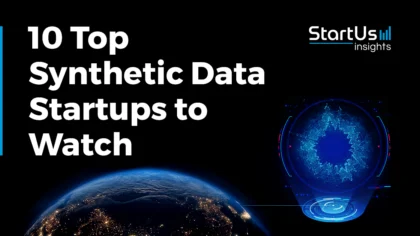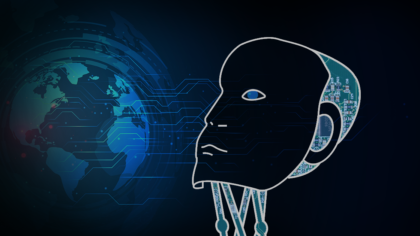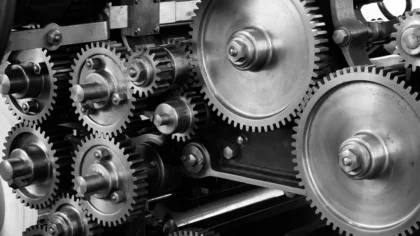Accelerate Productivity in 2025
Reignite Growth Despite the Global Slowdown
The 2025 Artificial Intelligence and Robotics Report explores trends like human-robot interaction, swarm robotics, and teleoperation, reshaping industries such as space exploration, healthcare, agriculture, and autonomous vehicles. It highlights startups, investment patterns, and market dynamics, offering stakeholders a concise view of the sector’s innovation and growth trajectory.
This report was last updated in January 2025.
Executive Summary: Artificial Intelligence and Robotics Report 2025
- Industry Growth Overview: The artificial intelligence in robotics market size will grow from USD 23.12 billion in 2025 to USD 64.74 billion in 2029 at a compound annual growth rate of 29.4%. On a micro level, there is an annual growth of 28.65% as per the Discovery Platform’s latest data.
- Manpower and Employment Pattern: The current employment in the sector is 69 000+. Additionally, around 8000 professionals joined the field last year.
- Global Footprint: The top countries for innovating the AI-robotics field are the United States, India, the United Kingdom, Japan, and China. Top cities for the same include Tokyo, London, Bangalore, San Francisco, and Singapore.
- Grants and Patents: More than 30 applicants filed 150+ patents. Additionally, the sector has more than 300 grants.
- Investment landscape: The sector closes over 1700 funding rounds, which supports more than 390 companies. The average funding amount raised in each round is USD 11.6 million.
- Top Investors: Top investors include Boston Dynamics, Oisix Ra Daichi Inc., BDC Capital, and more, whose combined investment is USD 750 million.
- Startup Environment: Top emerging startups like EnigmaTic (advanced AI-based robots), Earth Robotics (autonomous indoor robots), EndoCure (computer vision-based medical imaging robotic arm), JyoSH AI (AI-powered robots for cotton cultivation), Circus Group (autonomous kitchen robots) represent the developments in the AI-based robotics domain.
Methodology: How We Created This AI and Robotics Market Report
This report is based on proprietary data from our AI-powered StartUs Insights Discovery Platform, which tracks 25 million companies and 20 000 technologies and trends globally, including detailed insights on approximately 5 million startups, scaleups, and tech companies. Leveraging this extensive database, we provide actionable insights on emerging technologies and market trends.
For this report, we focused on the evolution of AI and robotics over the past 5 years, utilizing our platform’s trend intelligence feature. Key data points analyzed include:
- Total Companies working on the trend
- News Coverage and Annual Growth
- Market Maturity and Patents
- Global Search Volume & Growth
- Funding Activity and Top Countries
- Subtrends within AI and robotics
Our data is refreshed regularly, enabling trend comparisons for deeper insights into their relative impact and importance.
Additionally, we reviewed external resources to supplement our findings with broader market data and predictions, ensuring a reliable and comprehensive overview of the AI and robotics market.
What Data is Used to Create This Artificial Intelligence and Robotics Report?
Based on the data provided by our Discovery Platform, we observe that the artificial intelligence and robotics market ranks among the top 5% in the following categories relative to all 20K topics in our database.
These categories provide a comprehensive overview of the market’s key metrics and inform the short-term future direction of the market.
- News Coverage and Publications: The artificial intelligence and robotics market produces over 13 300 publications, which indicates a notable level of research productivity and media attention.
- Funding Rounds: Our database reveals more than 1700 funding rounds for the AI robotics sector.
- Manpower: The field employs 69 000 people currently and approximately 8000 more joined the workforce last year.
- Patents: The AI robotics field has more than 150 patents, which is a promising number for future innovations.
- Grants: The AI robotics projects receive more than 300 funds.
- Yearly Global Search: Over the past year, there has been a 64.4% increase in global search interest in AI robotics, which indicates growing professional and popular interest.
Explore the Data-driven Artificial Intelligence and Robotics Report for 2025
As per The Business Research Company, the artificial intelligence in robotics market size will grow from USD 23.12 billion in 2025 to USD 64.74 billion in 2029 at a compound annual growth rate of 29.4%
The cognitive robotics market is valued at approximately USD 6.6 billion in 2025, with a projected growth to USD 19 billion by 2037, at a CAGR of 10%.
The AI Robot Market Report 2025 uses data from the Discovery Platform and encapsulates the key metrics that underline the sector’s dynamic growth and innovation.
Our database reveals over 1380 firms and more than 910 startups working in the AI-robotics field. Last year, the sector grew by 28.65%, a sign of both technological breakthroughs and growing market demand.

Credit: The Business Research Company
With over 150 patents and 310 grants to date, intellectual property development is still a major driver of developments for the AIrobotics field.
Currently, 69 000+ professionals are working in the field with about 8000 more joining the workforce last year.
The top five country centers for research and innovation are the United States, India, the United Kingdom, Japan, and China whereas top cities include Tokyo, London, Bangalore, San Francisco, and Singapore.
In the United States, the AI robotics market is projected to reach USD 7.24 billion in 2025.
A Snapshot of the Global Artificial Intelligence and Robotics Market
More companies around the world are using robots powered by artificial intelligence, which led to a 28.65% yearly growth rate. This is a testament to both technology breakthroughs and rising market demand.
This number is supported further by 910+ working startups in the field. Further, there are over 1580 startups in the early stage and 30 more in the merger and acquisitions.
Additionally, 30+ applicants produce more than 150 patents. The 123.15% annual patent growth rate highlights the speed at which technology is developing and innovating.
With over 95 patents, China leads in patent issuing. An additional 30+ patents come from the US.
Explore the Funding Landscape of the Artificial Intelligence and Robotics Market
1700+ funding rounds and 1500+ investors participating in them demonstrate a promising landscape for the future of research and innovations. This funding supports more than 390 companies. The average funding raised in each round is USD 11.6 million.

Who is Investing in the Artificial Intelligence and Robotics Market?
Top investors in the AI-robotics field contribute USD 1.5 billion to the artificial intelligence and robotics market.

- Boston Dynamics invests USD 400 million in at least one company. Boston Dynamics announced a partnership with the Toyota Research Institute to advance robotics research.
- Oisix Ra Daichi Inc. invests USD 210 million in at least one company. Oisix Ra Daichi Inc.’s acquisition of SHiDAX led to a 119% sales increase and a 91% EBITDA rise.
- BDC Capital contributes USD 140 million to at least one company. BDC Capital launched a USD 300 million fund offering USD 3 million – USD 45 million equity investments to Canadian mid-market growth businesses.
- SoftBank Group Corp. distributes USD 139.1 million across two companies. SoftBank announced the Stargate Project, a new company planning to invest USD 500 billion over the next four years to build AI infrastructure for OpenAI in the US.
- Hongshan (HSG) spends USD 138.3 million across four companies. HongShan Capital Group (HSG) acquired a majority stake in Marshall Group for approximately USD 1.15 billion, with the Marshall family retaining over 20%.
- Samsung spends USD 116.4 million on at least one company. The U.S. Department of Commerce finalized an award of up to USD 4.74 billion to Samsung Electronics under the CHIPS Incentives Program.
- Brett Adcock invests USD 107 million in at least one company. Figure AI, founded by Adcock, secured USD 675 million in a Series B funding round.
- Kohli Ventures invests USD 100 million in at least one company.
- SoftBank Vision Fund spends USD 96.3 million on at least one company. Helion, a nuclear fusion startup, secured USD 425 million in funding from investors including SoftBank Group’s Vision Fund 2.
- Thrive Capital contributes USD 81.7 million to at least one company. Thrive Capital led a USD 6.6 billion funding round for OpenAI, contributing over USD 1 billion and valuing the company at USD 157 billion.
Microsoft has committed to a USD 80 billion investment in AI infrastructure, highlighting its dedication to advancing AI technologies.
Top AI Robot Innovations & Trends
Explore the emerging trends in the AI robotics field along with their firmographic details:
- Human-Robot Interaction has 126 enterprises concentrating on this field. 6100+ experts are employed in this field, and about 972 new hires were added last year. Further, strong market interest is indicated by its 14.48% yearly growth rate. Industries like manufacturing, healthcare, space research, transportation, etc. are benefiting from this particular trend.
- Swarm Robotics has 53 companies in this category and is growing steadily. Currently, the trend employs 800+ employees and added about 105 more last year. Its 6.36% yearly growth rate indicates steady and promising development. Innovations like the automatic design of control software, machine learning integration, hardware miniaturization, heterogeneous swarms, and phase transition adaptability are further improving the scope of applications for swarm robots.
- Teleportation shows a strong growing graph with an annual growth rate of 34.45%. There are 100+ companies in this sector, which employs over 4000 people. More than 730 employees joined the workforce last year. Various industries use teleoperation for intuitive control, communication technologies, and autonomous management. It also enables remote control in industries like oil and gas, manufacturing, healthcare, and more.
The integration of AI is expected to create a market opportunity worth USD 190 billion by 2025, emphasizing the role of AI in enhancing robotic capabilities.
Collaborative robots (cobots) are projected to account for nearly 35% of all robot sales by 2027, facilitating safer human-robot interactions.
Further, there is a growing focus on developing humanoid robots capable of performing tasks such as loading dishwashers or working on assembly lines, particularly in the automotive industry.
5 Top Examples from 910+ Innovative Artificial Intelligence and Robotics Startups
The five innovative startups showcased below are picked based on data including the trend they operate within and their relevance, founding year, funding status, and more. Book a demo to find promising startups, emerging trends, or industry data specific to your company’s needs and objectives.
EnigmaTic manufactures Advanced AI-based Robots
Saudi Arabian startup EnigmaTic builds AI-powered robots. The FlashBot is a building delivery robot. It features an ultra-sensitive e-skin, arrival notification, and AI voice interaction. The FlashBot automatically charges itself once it runs off charge.
It also comes with a UV sterile compartment with a UV germicidal lamp for sterilization. Additionally, EnigmaTic builds other robots for delivery like BellaBot, HolaBot, SwiftBot, and KettyBot.
There are robots for cleaning like CC1, which is suitable for edge cleaning, and Puductor2, suitable for air disinfection.
Earth Robotics provides Autonomous Indoor Robots
US-based startup Earth Robotics built Lu, a fully autonomous AI-powered indoor robot for delivering packages within residential buildings.
It features 4-wheel steering for curvy turns and a roller door for easy drop and pickup. The robot comes with a sensor architecture which includes cameras, radars, and lidar to evaluate its surroundings, and a lighting system to let people know of its activities.
Lu has precise location and planning tools, which provide a 360-degree field of view and assist it in error-free delivery.
The robot creates an indoor mirror map (IMM), which is a digital twin of the surroundings. The computer vision further assists the robot in segmentation, detecting objects, 3D map view, and local view.
It continuously learns from the detailed simulation and controlled testing. The elevator control provides access to standard elevators. Real estate companies use Lu for its perception, prediction, mapping, planning, and controlling capacity.
EndoCure builds Computer Vision-based Medical Imaging Robotic Arm
Israeli startup EndoCure provides the robotic AI-powered ultrasound system Revealan. It is radiation-free and provides higher resolution than MRI. It detects 1 mm lesion through an operator-independent 3D ultrasound imaging robot arm, which also integrates with all off-the-shelf ultrasound systems.
Revelean uses AI-powered computer vision software for 3D high-resolution mapping. It detects lesions after evaluating multimodality imaging.
Physicians use the resulting image for diagnosis, decision-making, and treatment strategy. The image is also used in routine follow-ups, and comparing lesion maps before and after therapy.
Revealan is suitable for endometriosis, adenomyosis, cancer detection, crohn and colitis, kidney stones, and minimally invasive procedure guidance.
JyoSH AI manufactures AI-powered Robots for Cotton Cultivation
Indian startup JyoSH AI builds integrated agricultural robots for cotton cultivation automation. The robot uses artificial intelligence, machine learning, and robotic technology to streamline activities like seed sowing, weed detection and removal, crop monitoring, and cotton picking.

The automation system addresses challenges like weeds, crop diseases, pests, insects, and lack of skilled labor.
JyoSH AI further plans to build an AI/ML platform and an advanced robotics platform, customizable for crops like cotton, rice, sugarcane, chili, fruits, and vegetables. The robots improve the productivity and profitability of farmers.
Circus Group provides Autonomous Kitchen Robots
German startup Circus Group creates a global autonomous food production system. It consists of CircusOS, a software for handling operations from inventory to handover, and Circus Robotics, an AI-powered kitchen robot for automating all major operations.
The CircusOS software further consists of Circus Connect for integrating into the existing app. It also features Circus Create for workflow optimization, Circus Control for operation automation, and Circus Complete for order fulfillment.
The autonomous food tech ecosystem empowers B2C food brands and is suitable for hospitals, retail centers, and airports.
Gain Comprehensive Insights into Artificial Intelligence and Robotics Trends, Startups, or Technologies
The integration of artificial intelligence and robotics optimizes perception and navigation, sensing and manipulation, autonomous operations, and error-free results. Further, trends like swarm robots, human-robot collaborations, and teleoperation are representations of the technology being fully utilized for increasing convenience in industrial operations.
The combination of artificial intelligence and robotics marks the beginning of many promising innovations. Additionally, the investment patterns, employment structure, and startup landscape suggest there will be more developments in the upcoming time.
Get in touch to explore all 910+ startups and scaleups, as well as all industry trends impacting 1380+ companies.





![10 Top Digital Twin Startups and Companies for Industry 4.0 [2025]](https://www.startus-insights.com/wp-content/uploads/2025/06/Digital-Twin-Startups-for-Industry-4.0-SharedImg-StartUs-Insights-noresize-420x236.webp)





